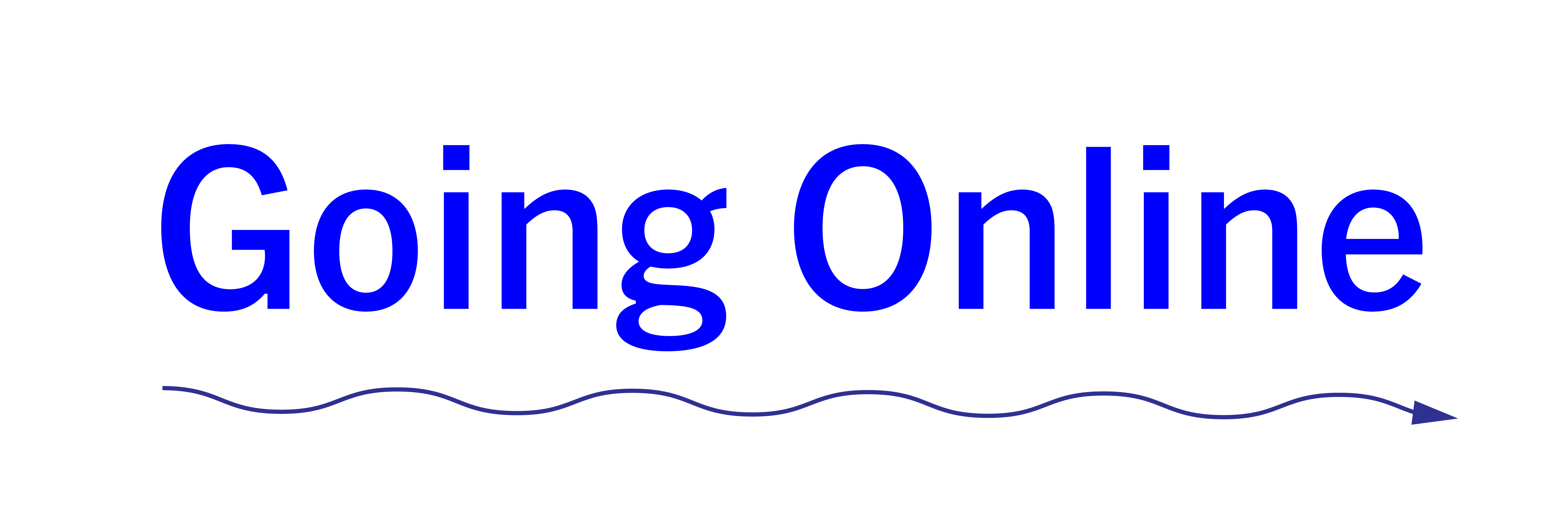Reminiscent of Space Beyond the Screen
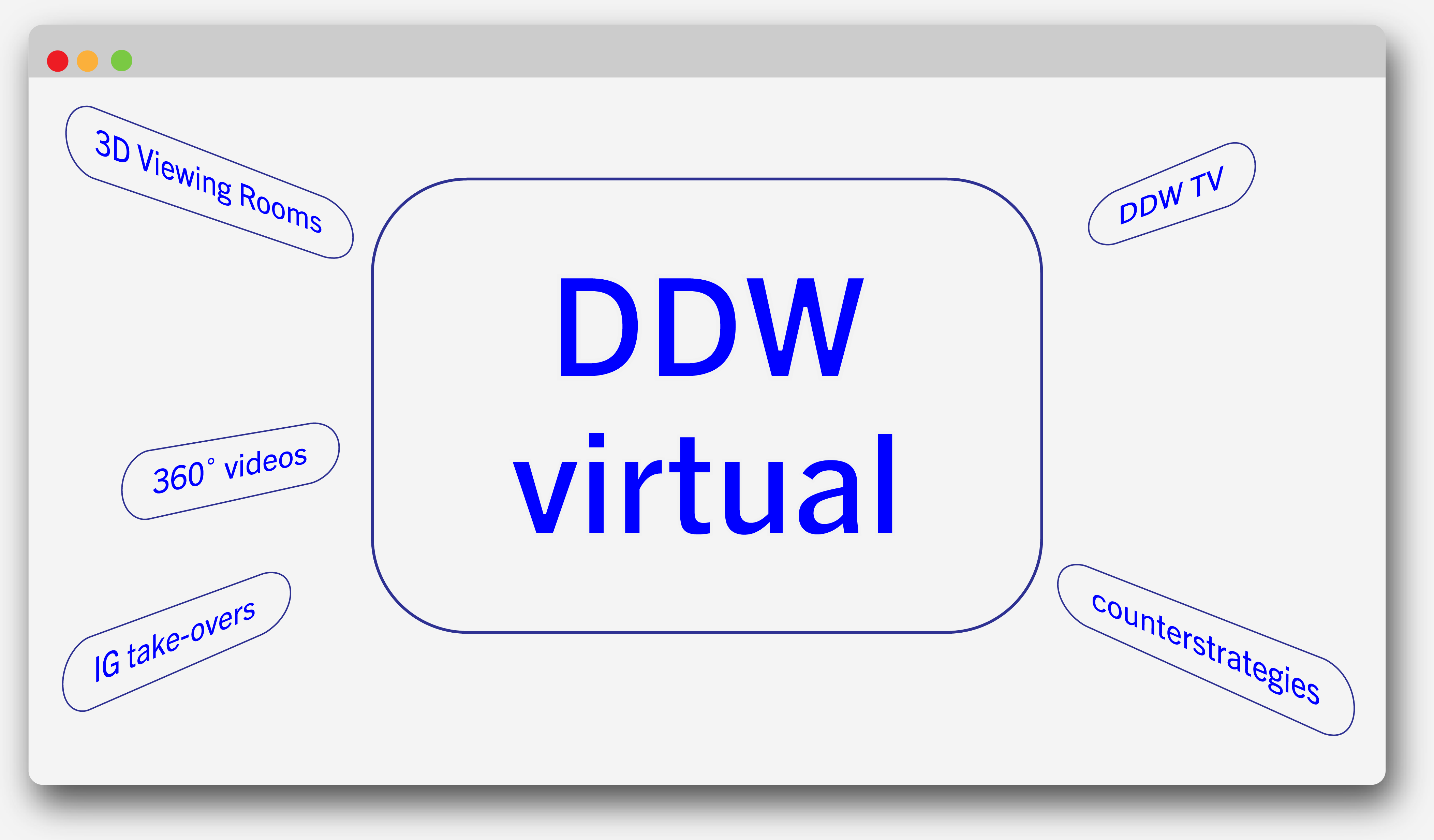
As a recent Design Academy Eindhoven (DAE) graduate myself, I was part of the last cohort of graduates to be able to present for a physical and live audience. Dutch Design Week (DDW) is quite an event. Annually an incredible number of lectures, panels, exhibitions, and presentations flood the city of Eindhoven, turning a calm medium-sized city into an event stage. Special DDW taxis bring international guests from A to B, the local coffee-places and restaurants are overfull, and hotels are overbooked weeks ahead. This year, none of that took place, as DDW had to decide to Go Online two weeks (!) before its launch. Instead, DDW was held on www.ddw.nl, presenting 3D Rooms, 360° video expositions, DDW TV, and Instagram take-overs. In this first post, I will give a glimpse into the various media used during Dutch Design Week. The second part will discuss the notion of liveness of the virtual formats.
In the four years the average student spends at a conceptual design school, nearly every project comes down to the same rule: form follows concept. What the project wants to communicate should be reflected in the choice of medium. Whereas (industrial) design education used to tell their students that ‘form follows function’[1], not every design project is functional. More than furniture and objects, projects range from sculptures to websites, campaigns, performative interventions, publications, systems, and speculative films. The chosen medium takes centre stage.
McLuhan’s famously stressed the importance of the medium in his publication ‘the medium is the massage’ (the title was initially a spelling mistake, but embraced by McLuhan for its accidental accuracy). McLuhan describes the message of the medium as the effects of technologies on the relationship between people. Examples he gives are theatrical productions, which may result in a new surge of tourism. Another example is newscasts, which message is (not the news content about crime but) the public’s shifted attitude towards crime.[2] The internet itself is a medium within which multitudes of media reside, shaping how we look at and make meaning of art and design.
What are the messages of the chosen media of Dutch Design Week?
Let’s dive in.
3D Viewing Rooms
What would usually have been presented in a spatial set-up is presented in 3D, using the spatial metaphor of the ‘room’. A one-color tunnel, in which visitors can move back and forth by pressing the arrow keys, the 3D Viewing Rooms show photos, videos, and text (either ‘floating’ or ‘hung’ on a digital wall). These rooms became the primary presentation medium for most design work, “It was hyped, there were big expectations” (Arvid&Marie, artist duo who performed at the opening of DDW). When I ask Eszter Dolák, a recent DAE graduate, about her experience of bringing her work online, she says: “I guess It felt like a story that we had to tell in the space, but to put it bluntly, it was like I was giving a PowerPoint presentation.”
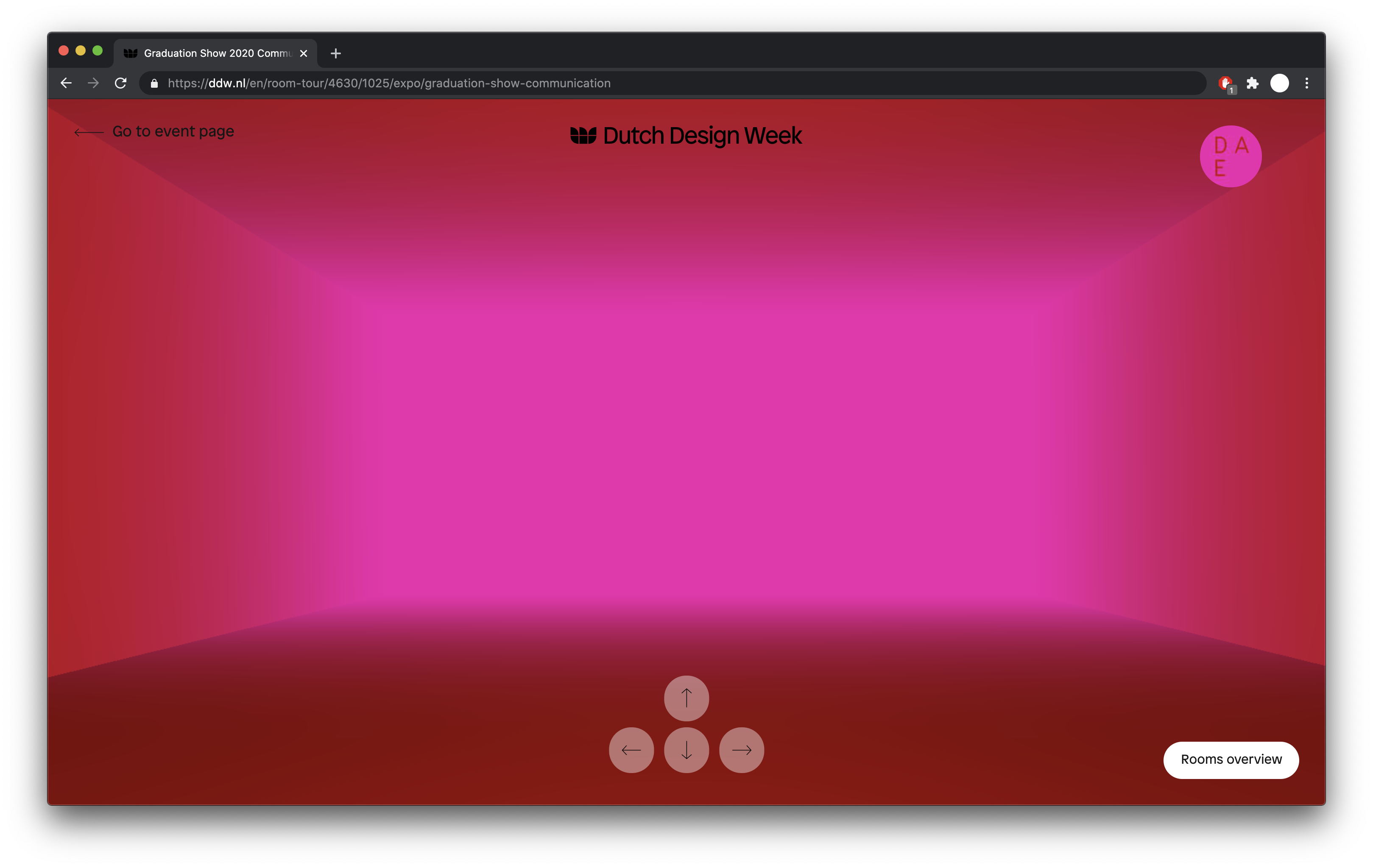 Some took advantage of the possibilities of this room. As experience designers, they shaped a digital journey for their publics. The going back and forward lent itself well for the project ‘Google Surge’ of the interaction designer Lauren Lundholm, which portrayed ‘an interactive, alternative timeline of Google’s growth.’ Other types of projects don’t lend themselves as much for these virtual rooms, yet online presentation does give other opportunities. Lauren: “There’s a lot to be said about things that are designed for the material world, the fact that you can see and feel them, understand the texture, all these different qualities. I think this format might lend itself more to show more process, or earlier sketches, images of models. Maybe the end product doesn’t translate as well. At the traditional graduation show, you never see anybody’s process. It’s just the final thing. I think that’s a different opportunity to show work, which is nice.” Whether online or offline, this is an aspect of large-scale exhibitions – or graduation shows – that collect projects with a large variety of topics and media. Not everything sits well in a large factory building, either. However, the choices for how to present work in these large factory buildings are much more extensive and meaningful. Placing an image right or left in a tunnel does not leave much open space to ‘design’ one’s project presentation.
Some took advantage of the possibilities of this room. As experience designers, they shaped a digital journey for their publics. The going back and forward lent itself well for the project ‘Google Surge’ of the interaction designer Lauren Lundholm, which portrayed ‘an interactive, alternative timeline of Google’s growth.’ Other types of projects don’t lend themselves as much for these virtual rooms, yet online presentation does give other opportunities. Lauren: “There’s a lot to be said about things that are designed for the material world, the fact that you can see and feel them, understand the texture, all these different qualities. I think this format might lend itself more to show more process, or earlier sketches, images of models. Maybe the end product doesn’t translate as well. At the traditional graduation show, you never see anybody’s process. It’s just the final thing. I think that’s a different opportunity to show work, which is nice.” Whether online or offline, this is an aspect of large-scale exhibitions – or graduation shows – that collect projects with a large variety of topics and media. Not everything sits well in a large factory building, either. However, the choices for how to present work in these large factory buildings are much more extensive and meaningful. Placing an image right or left in a tunnel does not leave much open space to ‘design’ one’s project presentation.
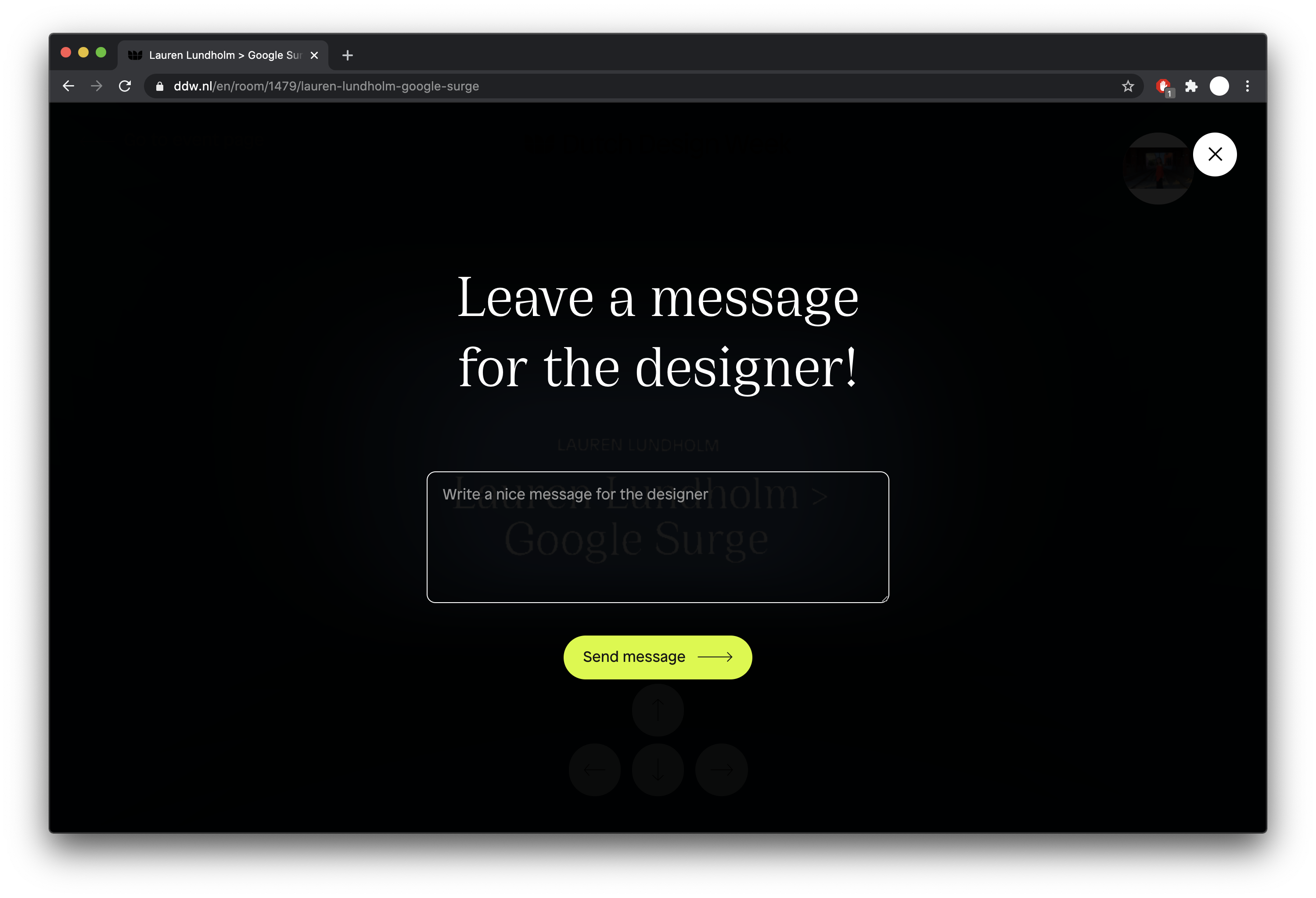 Key to the graduation show is the interaction with the audience – in the 3D Viewing Rooms, you could ‘leave a message’. Lauren: “If someone were interested, it wouldn’t be so difficult to contact me. But there’s a bit of a threshold. The person sending the message, I don’t know what they get out of it. You can’t respond to them. If they don’t leave contact details, you can’t reply. […] Someone can write a comment, leave feedback. But was is valuable about DDW is back and forth interaction to see if they are interested or not. This dialogue was really missing. I can’t see how many people landed on my room unless they tell me.” In an incredibly short time span, the 3D Rooms were chosen and created to present the graduation projects and other design projects. Maybe not a perfect solution, yet one that was done within the constraints of the context.
Key to the graduation show is the interaction with the audience – in the 3D Viewing Rooms, you could ‘leave a message’. Lauren: “If someone were interested, it wouldn’t be so difficult to contact me. But there’s a bit of a threshold. The person sending the message, I don’t know what they get out of it. You can’t respond to them. If they don’t leave contact details, you can’t reply. […] Someone can write a comment, leave feedback. But was is valuable about DDW is back and forth interaction to see if they are interested or not. This dialogue was really missing. I can’t see how many people landed on my room unless they tell me.” In an incredibly short time span, the 3D Rooms were chosen and created to present the graduation projects and other design projects. Maybe not a perfect solution, yet one that was done within the constraints of the context.
360° Video Expositions
Some of the physical events of DDW were open, with limited visitor capacity and strict rules regarding face masks and walking directions. For people who could not attend these in Eindhoven itself, the website hosts 360° video expositions. One such example is the Geodesign: Sand exhibition in Van Abbemuseum, a video that takes you through a collection of 360° videos of the different exhibition spaces. The medium does the job of giving an impression of the different spaces of the exhibition: “If it’s just about looking at what’s there, that’s okay. It’s always in the navigation that’s tricky. Navigating from one 360° to another, like in Google Streetview, is the clunky part, that takes you out of the immersion.” (Arvid&Marie)
Some artworks fit better in 360° than others. Watching a video on a screen within the 360° recording of the space on your own computer screen is a few levels too many for the content to come across well. However, every medium has its gems. Skip to 5:50 minutes and the tour arrives at the project ‘Landscope’ by Romain Laval and Baiba Soma. Seeing the stones wiggle in a 360° video is surprisingly satisfying, coming close (in a different way) to the poetry that the installation evokes in the physical room. You cannot hear the machinery creaking or the stones sanding and the video is too short to see sand pile up around the stones – yet for a moment, I feel immersed in the small spectacle. Like Jon Rafman capturing the unexpected and poetics of glitching realities in Google Street View in his project 9 eyes, these media do allow for poetic gems to be found if you spend enough time looking for it.
DDW TV
A big part of the 2020 edition of Dutch Design Week was DDW TV in which designers, artists, and curators had a conversation about their projects, ideas, and plans. Borrowing from the classic TV metaphor, the show is set up as a talk show and broadcasts to its audiences. “The TV show was supposed to be an addition, next to special events. With the professionals, they would have small curated tours. It would have worked nicely next to other content.” (Arvid&Marie) With the physical events canceled, DDW TV became the main element of DDW. The speakers sat down around a large table, each seat a microphone, digital speakers to joined the conversation on larges screens. Since the show had to move location 2 weeks before it happened, the space is near empty. Due to the restrictions, it wasn’t allowed for an audience to fill up the empty spaces. Some of the conversations were held entirely between remote speakers – for a few seconds, the empty studio became a backdrop for the conversation, like an inside-out Zoom background. It couldn’t be more fitting to the detachedness that everyone has experienced during the coronacrisis. Whereas physical events used to be confined to time and space, almost all talks of DDW TV 2021 are still available online – a clear upside to online talks.
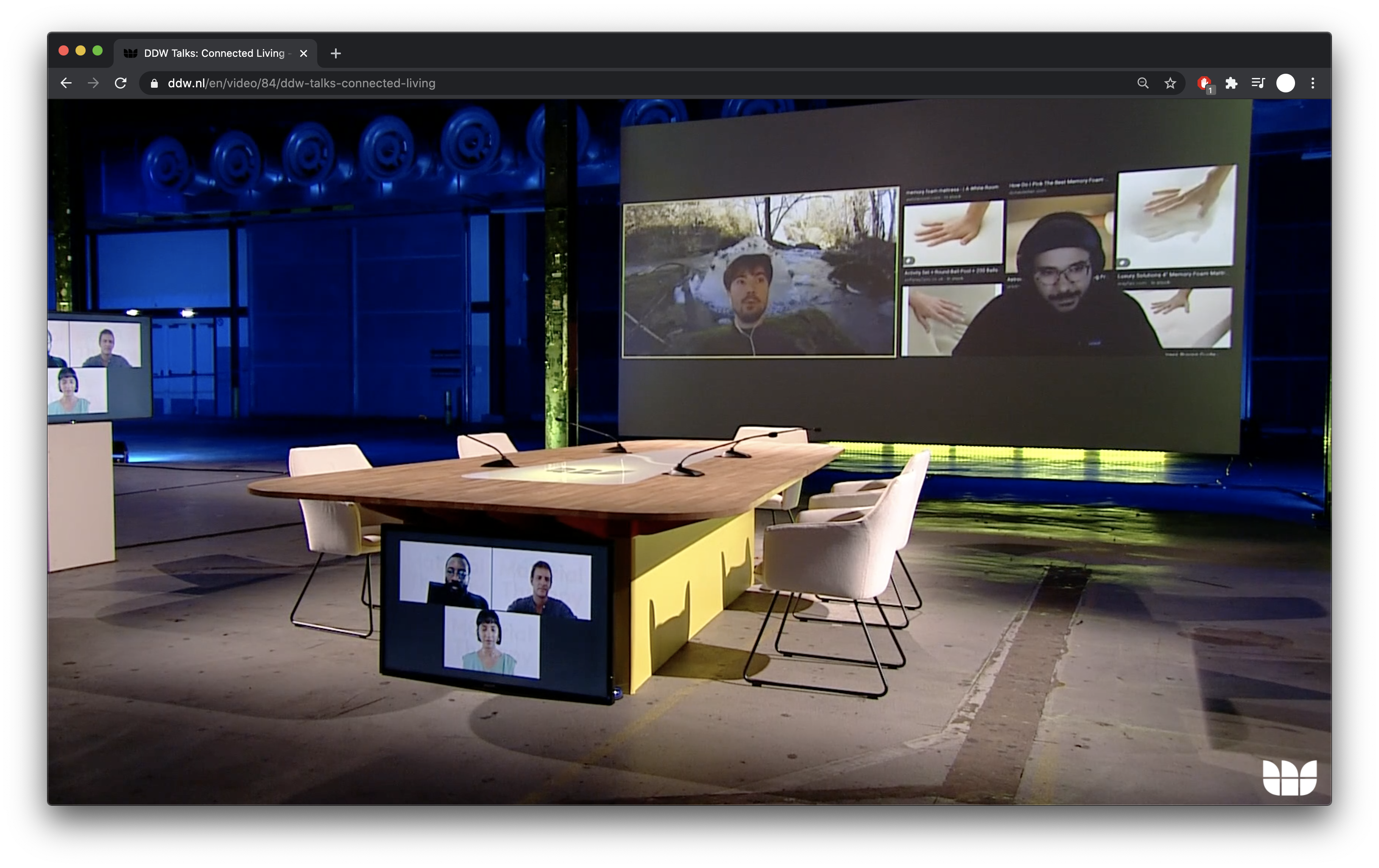
Counterstrategies
DDW Going Online was not an ideal situation, especially for the designers who had prepared for presenting their work in physical spaces. Different self-initiated projects formed counterstrategies against the limitations of the online platform.

Spreading the ‘This is not a grad Show’ posters through the city.
One of these counterstrategies is the ‘This is Not a Grad Show’ poster series, initiated by Ilja Schamle and Noa Jansma and developed together/in collaboration with Dominik Vrabič Dežman and Tom Neecobs. When I ask Ilja about the rationale behind the choice for posters, she says: “It was in response to DAE calling it an online graduation show, the graduation show, but online this year. We did not feel taken seriously, you cannot call that [3D Viewing Rooms] an online graduation show, perhaps a presentation, or catalog, but not an exhibition. By calling it that way, you also slightly undermine our grief that it cannot happen and what that means to us. The words they used are intended to make it positive, but they rule out certain conversations.” In response, a group of students hung 2.000 posters of the different graduation projects throughout Eindhoven, with a QR code to link to more information. “It’s not a graduation show, neither are these posters. It was an action to have more interaction with Eindhoven, and do something collectively with the graduates.” Following up on possibilities to interact, she says, “We had no direct communication with the city [of Eindhoven], and really missed that. This was one way to have that interaction. Not only the end result [of the posters spread throughout the city], but also the performative and interactive process of hanging the posters.”
Another counterstrategy of a different medium is a radio show by graduates, ‘(G)radio GS20’, initiated by Eszter Dolák and Elsa Sier. Together they had conversations with the DAE 2020 graduates about their projects, in the space of the RaRaRadio station Eindhoven. The conversations were streamed via Twitch and rararadio.com. When I ask Eszter what the radio show could offer that the online graduation show couldn’t, she answers, “Speaking, talking, interaction. There were live moments on the online show, there was this chat, but it was so disconnected. At the radio show we had people coming in, phoning in, asking questions on IG or Twitch in the moment. It felt more alive. It’s fun to have it run in the background, people can be doing whatever it is they are doing. It’s nice you can be so interactive but also passively listening. But we had this space in rararadio which was really great, it would be different only having people phoning in.” The radio show allowed for more informal conversations, in which projects could be discussed thoroughly.
Coming back to McLuhan – all the different media of DDW carried other messages. In various ways, these digital media, confined to the computer screen, seek connections to the spatiality of the world outside of the internet. The 3D Viewing Rooms seems to reference the different ‘rooms’ of a fair, the actual medium was best fit for compelling two-dimensional imagery. The 360° video expositions tried to bring the spatial character of the exhibition back onto the internet, a reminder that exhibitions are above all curated spatial environments. The empty studio of DDW TV was almost longing to be filled with an excited and engaged audience. The ‘This is not a grad show’ posters sought a connection to the city of Eindhoven, to the inhabitants of the city who may not easily open a browser window in a quest to find design. The student-led radio show found (new?) intimacy in the coziness of the space of RaRaRadio. What used to be ‘forms follows function’, became ‘form follows concept’. In the digital event formats during the coronacrisis, have we arrived at ‘form follows (the imitation of) space’?
References
[1] First coined by the architect Louis Sullivan in 1896, the phrase signifies that the shape of a building or object should be determined by its intended use.
[2] McLuhan, Marshall. 1967. This is Marshall McLuhan: The medium is the message. New York: NBC.


